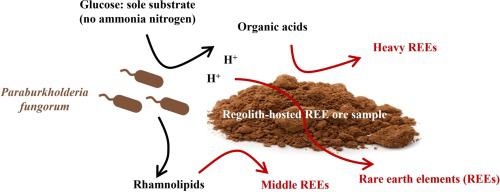当前位置:
X-MOL 学术
›
Miner. Eng.
›
论文详情
Our official English website, www.x-mol.net, welcomes your feedback! (Note: you will need to create a separate account there.)
Green and selective leaching of regolith-hosted rare earth elements by Paraburkholderia fungorum
Minerals Engineering ( IF 4.9 ) Pub Date : 2024-05-27 , DOI: 10.1016/j.mineng.2024.108749 Ling-Xiong Yuan , Tian-Lei Zhao , Wei Yin , Wen-Ping Liu , Qi-Zhi Yao , Gen-Tao Zhou
Minerals Engineering ( IF 4.9 ) Pub Date : 2024-05-27 , DOI: 10.1016/j.mineng.2024.108749 Ling-Xiong Yuan , Tian-Lei Zhao , Wei Yin , Wen-Ping Liu , Qi-Zhi Yao , Gen-Tao Zhou

|
Regolith-hosted rare earth elements (RH-REEs) are a strategic critical metal resource. The conventional technique of leaching RH-REEs by (NH)SO is facing the challenge of NH-N pollution. Bioleaching is a promising candidate, and shows unique potential in REE selective extraction. Herein, we examined the potential of to leach RH-REEs using glucose as the sole substrate. Bioleaching results showed that the strain efficiently leached the REEs, with preference for middle REEs (MREEs), followed by heavy REEs (HREEs) and light REEs (LREEs). The concentration of NH-N in the leachate was as low as 0.095 mg/L, excellently meeting the direct discharge limit (<15 mg/L) for REE industry in China. In addition, the leached impurities, including Fe and Al, were significantly reduced compared with (NH)SO leaching and other bioleaching routes. Analyses of the bacterial metabolism indicated that the special niche facilitated the REE leaching, and the metabolites rhamnolipids, oxalic and pyruvic acids played pivotal roles. The rhamnolipids and organic acids are responsible for the selective leaching of MREEs and HREEs, respectively, due to their preferential complexation with MREEs or HREEs. The organic acids also created an acidic environment beneficial to REE mobilization. Current results could provide insights into green and selective bioleaching of RH-REEs.
更新日期:2024-05-27
















































 京公网安备 11010802027423号
京公网安备 11010802027423号